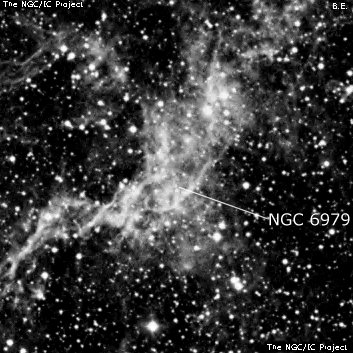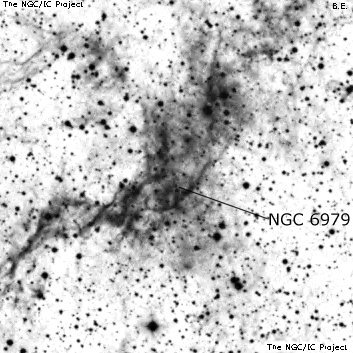NGC/IC Project Restoration Effort
(This is a very very beta version)
NGC6979


Basic Information
Location and Magnitude
Right Ascension: 20:50:30.0
Declination: +32:1:36
Constellation: CYG
Visual Magnitude:
Historic Information
Discoverer: Herschel W.
Year of discovery: 1784
Discovery aperture: 18.7
Observational
Summary description: vF, S, iE, sev F st f nr
Sub-type: SNR
Corwin's Notes
=====
NGC 6979 is a part of the Veil Nebula. However, WH's position for it is not
particularly good, and points to a very faint piece of the supernova remnant.
His description, from the sweep, reads, "F, S, crookedly E, r".
Dreyer has a note in the Scientific Papers: "Birr Castle, three times not
found, once eF nebulosity seen. Bigourdan, stellar, neb?" The one time that
the nebula was seen was on 16 August 1873 by Ralph Copeland. He has this to
say, "eF neby, f s end are 4 F sts forming a S arc. * 9.5m Pos 226.2 [deg],
Dist. 216.9 [arcsec]" (this note is the source of the comment in the NGC "sev
F sts f nr"). In principle, this could help us sort out which bit of
the Veil Copeland was looking at. Unfortunately, there are no stars as bright
as V = 9.5 in the area, but there are several at around 10-10.5. One,
GSC 02691-00200, is at 20 50 31.27, +31 57 18.5 (J2000), about the distance
Copeland measured from the patch of nebulosity usually taken as NGC 6979.
There are also four stars to the southwest forming more of a line than an arc,
but this is all I can find within about 10 arcminutes of WH's position. (For
the record, the four stars are at 20 50 45.0, +32 00 26; 20 50 44.3,
+31 59 30; 20 50 45.6, +31 58 46; and 20 50 46.2, +31 58 12; all for J2000.)
I, of course, don't know that these stars are the ones noted by Copeland, but
they more or less match his comment.
All this leads us 7-8 arcmin to the southwest of WH's position where we find a
brighter piece of the Veil that WH might have seen. Given nothing else
obvious in the area, I've taken this as NGC 6979 -- but with a colon.
See NGC 6960 for more on the Veil.
Steve's Notes
=====
NGC 6979
18" (8/3/11): this number is generally applied to the NW end of a fairly faint 20'x4' section of the Veil, located the NE of the northern end of Pickering's Triangular Wisp. The NW end is roughly 5'x3' and involves a few stars including a couple on the SW side and a couple on the north side. An isolated filament (section "F") oriented NNW-SSE is situated 10' ENE of NGC 6979. To the south of NGC 6979 the nebulosity thins and a faint thread extends to the SE before spreading out again on the SE end (see NGC 6974), about 15' from NGC 6979.
18" (7/31/08): this is the north end of a very elongated section of the Veil to the NE of Pickering's Wedge. Although the entire section is reasonably prominent at 73x using an OIII filter, the northern end which corresponds to the position of NGC 6979 doesn't really stand out, other than ending here and involving a few mag 10 stars. The north end of Pickering's Wedge is in fact much brighter with a wealth of filamentary detail.
17.5" (9/7/91): very faint, fairly large, elongated ~NNW-SSE, detached patch in the Veil Nebula. The SSE portion of this patch (identified in the RNGC as NGC 6974) is smaller and has several faint stars superimposed. The northern part (NGC 6979) is larger and wider but less well-defined and has some brighter stars superimposed. This patch is located NE of the northern end of the huge triangular wedge ("Pickering's Wedge") that forms the north central section of the Veil.



